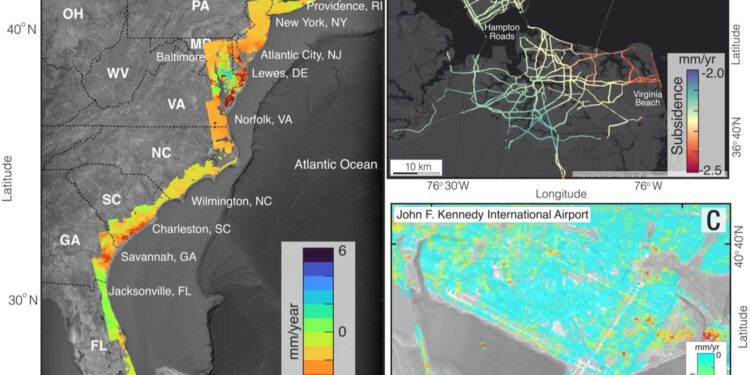The above graphic features: a spatial map of vertical land movement on the East Coast (left panel); primary, secondary, and interstate highways on Hampton Roads, Norfolk, and Virginia Beach, Virginia (upper right panel); and New York John F. Kennedy International Airport (lower right panel). The yellow, orange and red areas on these maps designate sinking areas. Credit: Léonard Ohenhen.
Major cities on the U.S. Atlantic coast are sinking, in some cases as much as 5 millimeters per year – a decline at the ocean’s edge that far exceeds global sea level rise, confirms a new study from Virginia Tech and the US Geological Survey.
Particularly hard-hit population centers, such as New York and Long Island, Baltimore, Virginia Beach, and Norfolk, are seeing areas of rapid “subsidence,” or sinking land, alongside land that is sinking more slowly. or are relatively stable, increasing the risk for roads, airstrips. , building foundations, railway lines and pipelines, according to a study published today in the Nexus PNAS.
“Continued, unmitigated subsidence on the East Coast of the United States should cause concern,” said lead author Leonard Ohenhen, a graduate student working with Associate Professor Manoochehr Shirzaei in the Earth Observation and Research Laboratory. innovation from Virginia Tech. “This is especially true in areas with high population and property density and a historical complacency toward infrastructure maintenance.”
Shirzaei and his research team gathered a large collection of data points measured by space-based radar satellites and used this highly precise information to create digital terrain maps that show exactly where declining landscapes pose risks to human health. vital infrastructure. Using publicly available satellite images, Shirzaei and Ohenhen measured millions of occurrences of land subsidence over several years. They then created some of the world’s first high-resolution depictions of land subsidence.
These groundbreaking new maps show that a large area of the East Coast is sinking at least 2 mm per year, and several areas along the mid-Atlantic coast extending up to 3,700 square kilometers, or more than 1,400 square miles, sinking more than 5 mm. per year, more than the current global rate of sea level rise of 4 mm per year.
“We measured subsidence rates of 2mm per year, affecting more than 2 million people and 800,000 properties on the East Coast,” Shirzaei said. “We know to some extent that land is sinking. Through this study, we emphasize that land subsidence is not an intangible threat. It affects you and me and everyone else, it may be gradual, but the impacts are real.”
In several East Coast cities, multiple critical infrastructures such as roads, railways, airports and sea walls are affected by different rates of subsidence.
“The problem here is not just that the land is sinking. The problem is that the hotspots of land collapse directly intersect the population and infrastructure poles,” Ohenhen said. “For example, significant areas of critical infrastructure in New York, including JFK and LaGuardia airports and their runways, as well as rail systems, are affected by subsidence rates greater than 2 mm per year. The effects of these, now and in the future, are potential damage to infrastructure and increased risks of flooding.
In their paper titled “Slowly but Sure: Exposing Communities and Infrastructure to Subsidence on the US East Coast,” scientists from Virginia Tech and the US Geological Survey (USGS) measured the extent of the land subsidence along the East Coast and which areas, populations, and critical infrastructure within 100 km of the coast are at risk of land subsidence.
Subsidence can undermine building foundations; damage roads, gas and water pipes; cause a building to collapse; and worsen coastal flooding, particularly when associated with sea level rise caused by climate change.
“This information is needed. No one else is providing it,” said Patrick Barnard, a USGS research geologist and co-author of the study. “Shirzaei and his team at Virginia Tech have jumped into this niche with his technical expertise and are providing something extremely valuable.”
More information:
Leonard O Ohenhen et al, Slowly but surely: exposing communities and infrastructure to subsidence on the US East Coast, Nexus PNAS (2024). DOI: 10.1093/pnasnexus/pgad426
Provided by Virginia Tech
Quote: Study: From New York to Washington DC and beyond, East Coast cities are sinking (January 2, 2024) retrieved January 2, 2024 from
This document is subject to copyright. Except for fair use for private study or research purposes, no part may be reproduced without written permission. The content is provided for information only.



